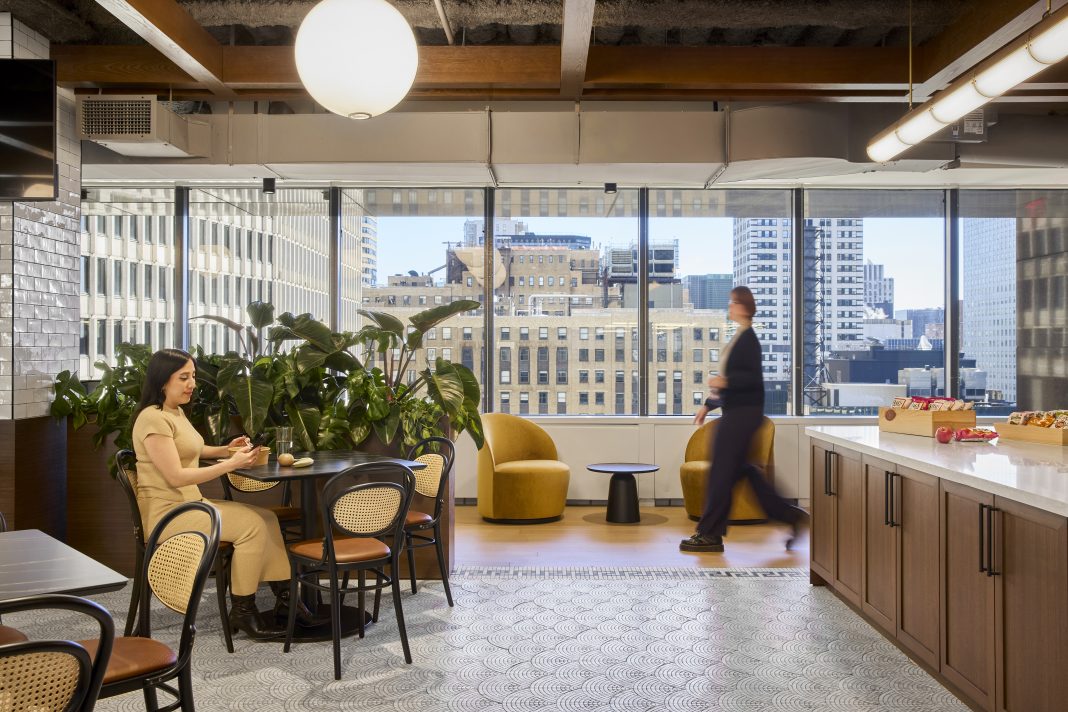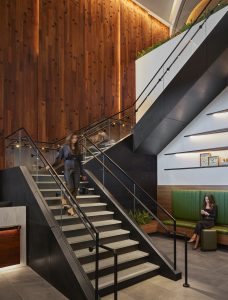Where and how we work is evolving far beyond the office — today, people work on trains, planes, and in increasingly sophisticated airport lounges.
Offices are now just one place where work gets done. What can workplaces learn from these high-design, innovative spaces that provide exceptional hospitality, luxe amenities, and an elevated sense of well-being? What insight can be gained from how people work while traveling — and how could that help influence the future of the workplace?
Exploring the topic are two authors, Corgan’s Emily Strain, Director of Workplace Strategy, and Ginger Gee DiFurio, Aviation Sector Design Director and lead designer of award-winning lounges including the Chase Sapphire Lounge at LaGuardia Airport and The Club SFO by Airport Dimensions.
The Welcome
The exclusive feel of a great airport lounge begins with the welcome, through both hospitality and design. In a sea of options, airport clubs strive to make a memorable first impression on travelers. Workplace reception spaces are an opportunity for more than just a security checkpoint – they should be seen as an experience to entice and excite visitors for what’s next.
The Concept: Designers generate excitement by thinking not just about the design and branding of the entryway, but about the energy of the amenities or design elements a guest can see past the front desk. For example, The Club SFO entry is a grand, light-filled, two-story space with towering wood-paneled walls and a grand staircase. At the top of the stairs, a glimpse of a stylish fireplace and cozy lighting encourage guests to explore and discover the lounge. This welcome is reinforced through multisensory design – a layered experience evoked with signature scents, thoughtful lighting levels, music, and texture.
The Lesson: Workplace design can pull from the concept of evoking a warm welcome and thoughtful first impression. Designers should consider what amenities, spaces, or design features — like a monumental stair or hospitality station — are most impactful and place those in view of the entry to draw people in. Where security considerations can make this strategy difficult, designers can focus on providing an impactful, multisensory experience through scent, light, and texture.
Consistency & Delight
Airport lounges walk a fine line between providing consistency at each far-flung locale while also curating a new, localized experience to delight guests. While the emotional safety that reliability provides is vital in fostering a positive experience, providing “discovery moments” can make an otherwise conventional experience more compelling.
The Concept: Lounges create reliability by ensuring that the level of service and sequence of amenities are constant across each location. However, both airports and clubs have seen the value of localization through material choices, art selection, and even larger design elements, like the surfboard wall at the Chase Sapphire Lounge by The Club at SAN. These discovery moments are carefully planned to surprise and delight guests without interfering with the basic function of the lounge.

The Lesson: In workplace design, finishes and furniture can provide a cohesive look across offices while integrated technology can provide a seamless experience. However, just as lounges seek to have something new to delight even the most experienced traveler, the workplace can incorporate smaller changes – like rotating snack offerings in a break room – or unexpected, regionally-inspired artwork – as seen in the team member lounge space at the new Wingstop HQ in Dallas.
Wellbeing Matters
Travel can be hard on your body — the greasy food, jet lag, and odd hours all take a toll. Airport lounges seek to reduce the stress, both physical and psychological, of travel through design and amenities. By making decisions that enhance wellbeing, lounges facilitate more focused work alongside a relaxing experience.
The Concept: Wellness in lounges starts as early as the programming phase. Limited space necessitates strict metrics for occupancy — to accommodate all types of guests, the lounge is zoned by energy level. A bustling central bar might be surrounded with high-energy areas like dining and socializing lounges while quieter or more individual areas like a fitness room, shower, or phone booth are placed farther away. This allows guests to choose the energy level that best suits their needs, whether that means blowing off steam at the bar or taking a yoga class in a quiet room with a workout mirror.
Lounges also place high importance on food and beverage offerings. Research suggests that food intake can desynchronize circadian rhythms, which may already be disrupted from travel. In contrast to other airport concessions, lounges provide smaller portions and healthier options to better support traveler’s wellbeing.

The Lesson: Lounges can do a lot for a wide range of people with little space because they know their clientele. By digging deep into an organization’s culture — how they work and what they need to do that work — designers can tailor the workplace’s programming to support a range of activities and energy levels, even in a small space. Organizations can also learn from lounges’ food offerings. Even if a full cafeteria isn’t feasible, convenient access to healthy food in a breakroom can help improve focus and energy levels throughout the day.
Final Thoughts
Employees are quick to whip out their laptop in an airline club and work, yet hesitant to move around in a workplace full of multiple options and locations to work. Do our daily routines in the workplace drive behaviors like returning to the same desk each day? And, how can organizations infuse the fun and exclusivity of travel into their workplaces? Next time you pass through an airport lounge, look at how people are using the space and consider what travel and workplace designers can learn from each other – there might be more in common than you’d think.
Images courtesy of Corgan




